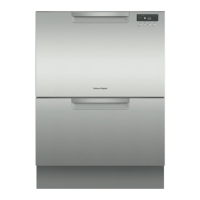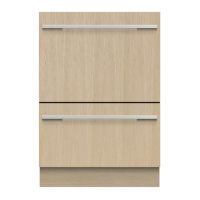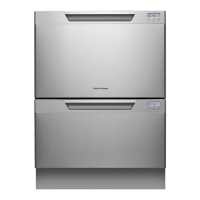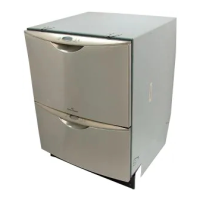2
(min. 12 ¼ ” (311.5 mm))
Product preparation
Double DishDrawer models
A
C
Installation diagrams for illustration purposes only
The following calculations assume the top of the upper panel is aligned with the top of the
adjacent cabinetry. The nal panel/cabinetry alignment is achieved by adjusting the feet:
width of ALL panels
Measure
A (
the width between adjacent door/drawer fronts) and write it in the rst box below,
then complete the equation.
i.e
- 2 x =
height of upper panel
i.e
15 ⁄”
+ =
height of lower panel
Measure
C (
door/drawer height (or equivalent)) and write it in the rst box below,
then complete the equation.
i.e
30 ”
-
15 ⁄”
-
⁄”
=
14 ⁄”
- -
⁄”
=
Note: The ‘door extension’
B
allows for the top of the upper panel to be above the DishDrawer® where required.
min. ⁄”
(2.5
mm)
width of ALL panels
min. ⁄”
(5
mm)
min.
⁄”
(5 mm)
upper
panel
height of
upper panel
A
door clearance panel width
A
width ALL panelsdoor clearance
(min. 23 ⁄” (595 mm))(min. ⁄” (2.5 mm))
Air gap
lower
panel
toe kick panel
B
height of
lower panel
32
¼ -
34
⁄”
(819.5 - 879.5 mm)
28
⁄
“
(735 mm)
D
height of
toe kick
panel
⁄” (8mm)
Air gap
B
height
upper panel
standard height
B door extension
(0 mm recommended)
C
height
upper panel
height
lower panel
C
(min. 28 ¼ ” (717.5 mm) + B))
height upper panel
Air gap
height lower panel
height upper panel
min. ½ “
(12 mm)
min. ⁄”
(2.5
mm)
24 ¼ ”
- 2 x
⁄”
=
24 ⁄”
(616 mm) (2.5 mm) (611 mm)
15 ⁄”
+ 0
”
=
15 ⁄”
(398 mm) (0 mm) (398 mm)
(398 mm)
(762 mm) (398 mm) (8 mm) (356 mm)
(8 mm)
US CA

